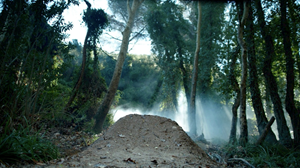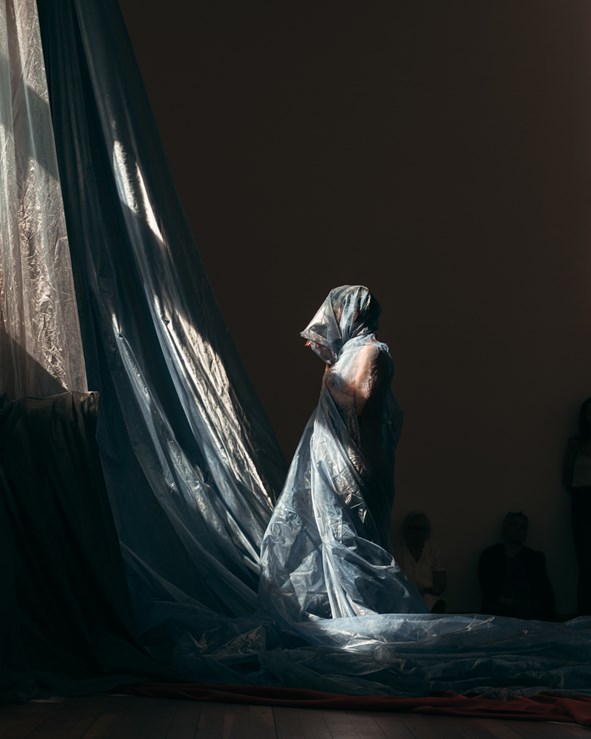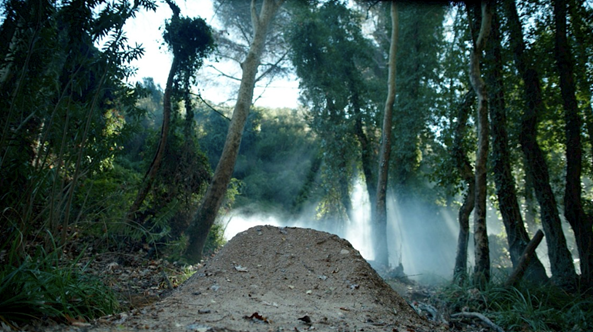
Following a year-long residency at the Gropius Bau, Wu Tsang’s solo exhibition There is no nonviolent way to look at somebody presents a survey of her unique filmmaking practice and is the German premiere of her new film installation, One emerging from a point of view (2019).
Image: Still from "One emerging from a point of view", courtesy to the Artist and Galerie Isabella Bortolozzi, Berlin
Following a year-long residency at the Gropius Bau, Wu Tsang’s solo exhibition There is no nonviolent way to look at somebody presents a survey of her unique filmmaking practice and is the German premiere of her new film installation, One emerging from a point of view (2019).
Fusing the registers of fiction and documentary, the artist deploys magical realism as a strategy to reimagine racialised, gendered representations beyond the visible frame and to encompass the multiple, shifting perspectives through which we experience the social realm. In the exhibition, films are shown in dialogue with the artist’s sculptural practice, working with the interaction of glass, light and text, and including a new stained glass commission conceived for the Gropius Bau.

Wu Tsang, Boychild, Untitled
'A crucial aspect of Wu Tsang’s practice is her radical approach to documentary film. Her work allows cinematic parallels to emerge between the construction of the moving image, the movement of the performing body and the movement inherent to migration. The way she uses the camera enables gesture, choreography and dance to serve as narrative forces. At the Gropius Bau, we trace the collaborative relationships that underpin her sculptural and filmmaking practice.'
– Stephanie Rosenthal, Director and Curator
With its hybrid cinematic language, Wu Tsang’s new film One emerging from a point of view examines the present and the political, dealing especially with the experience of migration. Filmed on the Greek island of Lesbos, it addresses the current situation that the landscape and islanders have been confronted with: the trauma of forced displacement. In 2015 alone, over 850,000 refugees reached Greece, many arriving at the shores of the island Lesbos, having travelled over the sea to flee war and untenable political circumstances. Documenting within this context, Wu Tsang employs a magical realist approach, allowing the boundaries between fact, fiction and surreal narrative to be intentionally fluid. What has commonly been referred to as a “refugee crisis” is structurally encountered in the film as a crisis of representation.
 Still from "One emerging from a point of view", courtesy to the Artist and Galerie Isabella Bortolozzi, Berlin
Still from "One emerging from a point of view", courtesy to the Artist and Galerie Isabella Bortolozzi, Berlin
In the face of the impossibility of creating images in the throes of such personal and political trauma, Wu Tsang seeks to create films in which hybridity can gain expression. Stemming from traditions of documentary filmmaking, her approach to the moving image is a central aspect of the exhibition. One emerging from a point of view is screened via two overlapping video projections where images cut and bleed into each other, a technique also seen in the 2017 film We hold where study. Both films use rigorous camera choreography to entangle disparate worlds and psychological spaces, revealing an indeterminate “third” space, which is produced through the overlapping projections.
We hold where study (2017) presents choreographic duets in which bodies press against one another and fall in and out of entanglement. Screened as two projections, they overlap at points, creating an in-between cinematic space. Featuring performance artist boychild with dancer Josh Johnson, choreographer Ligia Lewis with Jonathan Gonzalez, and music by Bendik Giske, the film forms part of the artist’s meditation on image-making and mourning. The film responds to an essay called Leave Our Mikes Alone by Fred Moten and Stefano Harney, and proposes a visual vocabulary that poetically approaches practices of blackness and queerness through a choreography of bodies that attempts not to collate or collapse, but to enact their “difference without separability”, to borrow a phrase from the theorist Denise Ferriera da Silva.
Wu Tsang’s ongoing collaboration with Fred Moten is palpable in many of her works, particularly Girl Talk (2015), where Moten is filmed joyfully moving in a sun-filled garden, overlaid with a haunting acapella by Josiah Wise. With a slightly slowed frame speed, Moten languishes in the sun, emblematic of the heady heat of a summer’s day. In exploring the figure of the drag queen and the mother, Moten and Tsang, poet and artist, remain unfixed in any one persona.
Collaboration as a strategy for entering into what she terms “in-betweenness” is an integral part of Wu Tsang’s practice. In her works she consciously layers the gestures, words and voices of others, allowing multiple perspectives to emerge. In keeping with this, the exhibition There is no nonviolent way to look at somebody includes the photography of two of Wu Tsang’s key collaborators, boychild and Eirini Vourloumis. Their photos are shown in the rooms preceding We hold where study and One emerging from a point of view respectively, prefacing the film installations in which boychild and Vourloumis each play central roles.
Further to the writings of Fred Moten and Stefano Harney, Wu Tsang’s work can also be read in relation to the thinking of Édouard Glissant. In particular Glissant’s understanding of opacity informs both her film-based practice and site-specific stained glass sculpture. Glissant famously argued for “the right to opacity for everyone” which he further elaborated on in Poetics of Relation, which was first published as Poétique de la Relation, 1990. He writes, 'The opaque is not the obscure… It is that which cannot be reduced' (p. 191). He understands opacity as an ethical stance that acknowledges the imperialist and dominating problematics of demands for “transparency” when so much of experience and identity exceeds categorisation, and the schemas of visibility and representation have such profound limits.
For Wu Tsang, the site-specific stained glass sculpture Sustained Glass (2019), allows for an aesthetic encounter with opacity, as what is presented is a text that cannot fully be read and a material that is not fully see-through. The act of seeing is understood not as an empirical search for understanding, but as an act infused by mystery, where seeing becomes a devotional field of feeling. The work is also inspired by her direct engagement with the Gropius Bau during her residency in 2018, and a broader continuation of the artist’s exploration of working with light and glass. Taking on the proportions of the building’s large 19th-century windows, the sculpture inverts the tradition of stained glass windows depicting allegorical stories through images. Here, words were etched into the glass using acid, forming an overlapping text that fades in and out of legibility, and it is the materiality itself that adds a layer of allegory. The handcrafted stained glass is luminous and fragile, vulnerable and marked by toxic encounter – a material that neither fully obscures light, nor is fully transparent, providing a poetic reflection upon the tensions between transparency and opacity.

ArtDependence Magazine is an international magazine covering all spheres of contemporary art, as well as modern and classical art.
ArtDependence features the latest art news, highlighting interviews with today’s most influential artists, galleries, curators, collectors, fair directors and individuals at the axis of the arts.
The magazine also covers series of articles and reviews on critical art events, new publications and other foremost happenings in the art world.
If you would like to submit events or editorial content to ArtDependence Magazine, please feel free to reach the magazine via the contact page.